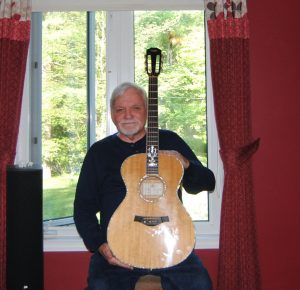During the mid 1920s, the unexpectedly strong sales of Blind Lemon Jefferson’s Paramount 78s sent record scouts scrambling throughout the southern United States to sign other blues artists. One of their best discoveries was Arthur “Blind” Blake (1896-1934), a sophisticated guitarist whose warm, relaxed voice added to his appeal. Today, the man with the “piano-sounding guitar” is still regarded as the master of ragtime and blues guitar fingerpicking. Some of his songs feature some raucous boogie-woogie phrases that he must have picked up from some of his contemporaries like the great Meade Lux Lewis, a master of the boogie-woogie piano. Certainly, no other guitarist played phrases like that at that time.
Very little is known about Arthur Blake. He was born blind and there were some questions as to his real name – he was simply known as Blind Blake all his life. His single surviving photo is a promotional print made by his life-long recording company, Paramount Records. It shows Blake sitting cross-legged, dressed in his Sunday best and playing a small parlour guitar. In one of the most callous and insensitive decisions I’ve ever comer across, Paramount included a dedication on the lower part of the photo saying “Cordially Yours, Blind Blake”, in a flowery script. Anyone can see from his sunken eyes on the photo that Blake is bling and, obviously, incapable of writing. Anther example of the blatant disregard for black artists in that era.
Arthur Blake’s recording career spanned six years, from 1926 to 1932, all with Paramount Records. In that time, he was extremely popular and recorded some 80 sides as a solo artist as well as playing guitar for artists like Leola Wilson, Ma Rainey, Bertha Henderson, Chocolate Brown and many others. He was the most gifted guitarist of his era, had a powerful voice and was comfortable with ragtime, ballads or blues.
Paramount’s ads in the Chicago Defender, a popular African-American newspaper, emphasized Blake’s guitar style, which was often compared to a piano because of his magnificent dexterity on the instrument. Of all his songs, “Police Dog Blues”, recorded in 1929, is my favourite. Not only is the song a classic example of Blake’s sophisticated guitar work and solid vocals, it is humourous and yet also paints a stark picture of the life of an itinerant musician during the inter-war years.
Being blind, Arthur Blake’s life was harder than most. It was a time of severe segregation, where black people could not sleep in the same rooming houses, eat in the same restauraunts or even drink from the same water fountains as white people. There was no Green Book (which was published after Blake’s death) to help black people decide on “friendly” accommodations. In “Police Dog Blues”, Blake talks of travelling, staying alone, making shipping arrangements for his trunk to follow him wherever he played. For a blind black man, an easy prey for thieves, it was a hard life and you did the best you could.
In 1932, the Great Depression caught up with Paramount Records and they went out of business. Blake never recorded again and he died in 1934. Facts about Blake’s life and his death were hard to come by. The Reverend Gary Davis believed he had been run over by a streetcar, a plausible fate for a blind man. It wasn’t until 2011 that facts finally surfaced when a group of researchers led by Alex van der Tuuk published various documents regarding Blake’s life and death in the journal “Blues and Rhythm.”
Working from a small obituary found in the Chicago Defender, they searched the Milwaukee area and found a remote part of the cemetery where he had been buried (Glen Oaks), the grave found in a bush along with garbage and an American flag. .From the 1934 death certificate they found, we now know that Blake was born in Newport News, Virginia and married Beatrice McGee in 1931. This is extremely comforting to me – Blake finally had someone to share his lonely and dark world with.. It must have felt like the weight of the world had been lifted off of his shoulders.
In April 1933 he was hospitalized with pneumonia and never fully recovered. On December 1, 1934, after three weeks of decline, Beatrice Blake summoned an ambulance. He died on the way to the hospital, the cause of death listed as pulmonary tuberculosis. Blake was buried in Glen Oaks Cemetery, in Glendale, Wisconsin in a previously unmarked grave. The county paid for the burial so the popular artist heard and enjoyed by so many was never paid for his efforts, like many others. Thanks to the exemplary work by van der Tuuk and his researchers, Arthur Blake now has a headstone, as does his wife Beatrice.
In 2004, to commemorate 30 years of guitar making, the Taylor company introduced a limited issue Grand Concert series guitar featuring a classic slotted peg head, elaborate pearl and 18k gold inlay, the best quality woods and state-of-the-art construction techniques. It is a vintage, prior to 1930 look that I’ve been looking for since I saw Jimmie Rodgers’ magnificent 1928 Martin guitar. Not surprisingly, one of these rare beauties found its way into the exquisite collection of my long-time friend Pépé (Pierre Pinard). Following casual negotiations between two good friends, that guitar is now part of my collection. I used it in my recording of “Police Dog Blues” and it will be my guitar of choice from now on.
Richard Seguin – voice and acoustic guitar


Ajouter un mot
You must be logged in to post a comment.